2nd Part
ANCIENT JEWELLERY EXHIBITED
IN ANATOLIAN CIVILIZATIONS MUSEUM
Hand-Arm Jewellery
Rings
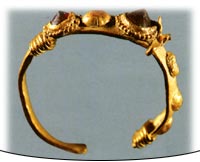 | Name: | Ring (with stone) |
| Type: | Gold |
| Location where it came from: | Keban, Ağın |
| Way of Coming: | Exc. find |
| Dimensions: | D: 1.8 cm |
| Weight: | 1.82 gr |
| Period | The 2-3rd century BC |
Various ornaments are placed on a flat and wide ring with an asymmetric arrangement. On two ends, there are wires wrapped on ring. After that, there are three cabaras on one side and again a wrapped wire. After this wire, there are two red stones placed in small, round slots and a cabara between them. The perimetre of the slots in which the red stones are placed is ornamented with a row of granule. A part of the ring is missing.
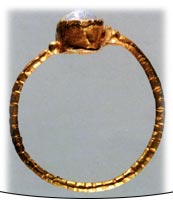 | Name: | Ring (with stone) |
| Type: | Gold and glass paste |
| Location where it came from: | Uşak, Kula |
| Way of Coming: | Purchase |
| Dimensions:: | H: 2.1cm W:1.9cm |
| Weight: | 0.65gr. |
| Period: | The 3rd century AD |
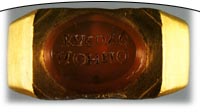 | Name: | Ring (with stone) |
| Type: | Gold and sard |
| Location where it came from: | Not known |
| Way of Coming: | Not known |
| Dimensions:: | H: 1.8cm W:2.15cm |
| Weight: | 8.55 gr. |
| Period: | The Late Roman Period |
A solid and wide seal ring is round edged on the lower side and sharp edged on the upper side. A high sard in the form of an ellipse, with an inscription on it is placed in the slot in a rectangle with rounded edges in the middle. In the inscription, that has two rows and in inverse direction from right to left, A?HNO - K?EOVC (Athenokleos') is read.
 | Name: | Ring ,seal |
| Type: | Gold |
| Location where it came from: | Alacahöyük |
| Way of Coming: | Exc. find |
| Dimensions:: | H:1.9cm W:2.5cm |
| Weight: | 18.87 gr. |
| Period: | The 14-13th century BC |
A circular flat plate is soldered to a grooved wide ring. There is a carved hieroglyph inscription on it in the middle and a wide knitted band and a thin band around it. It is understood from a hieroglyph that the ring belonged to a person named La - la - su. Furthermore, “(a) nkh”, which is the symbol of life, is written near the name.
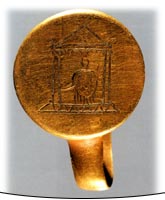 | Name: | A Ring |
| Type: | Gold |
| Location where it came from: | Gordion |
| Way of Coming: | Exc. find |
| Dimensions:: | D: 1.8 cm |
| Weight: | 7.25 gr. |
| Period: | The 4th century BC |
Its wide, crushed ring is soldered to a circular upper part. The front of a templum in antis planned temple made with carving is placed on it. The acrotaries of the temple, its diadem representing a rosette and a goddess sculpture standing up are seen. tte and a goddess sculpture standing up are seen.
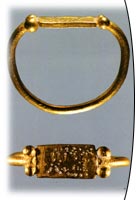 | Name: | A Ring |
| Type: | Gold |
| Location where it came from: | Keban, Ağın |
| Way of Coming: | Exc. find |
| Dimensions:: | H: 1.5cm W:1.85cm |
| Weight: | 1.97 gr. |
| Period: | The 2-3rd century AD |
Big golden spheres are soldered to the ends of the short edges of a rectangular golden plate ornamented with points and this is attached to a thick and soft sectioned ring.
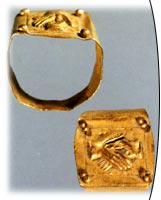 | Name: | Ring |
| Type: | Gold |
| Location where it came from: | Uşak, Eşme |
| Way of Coming: | Purchase |
| Dimensions:: | H: 1.7cm W:1.6cm |
| Weight: | 2.4 gr. |
| Period: | The 3rd century AD |
A ring that is thin on the lower side widens upwards and gets thinner and becomes a square plate. Its two edges opposite each other are a bit ovalized. A rectangular frame is drawn in it and one large granule is soldered to each corner. A relief of two hands joined in a handshake (Dextrarum Iunctio), which is the symbol of peace and friendship and which is seen also on the coins, is placed in the frame.